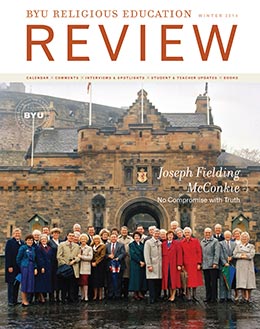This issue of the Review features some of the excellent work being done by the faculty in Religious Education as well as the enduring contribution of the part-time faculty members who teach courses for Religious Education. Within these pages you will see the breadth of scholarship that is currently under way: research on the history of Liberty Jail and the Church’s presence in Missouri; research into the translation process of the Book of Mormon; and two recent conferences, one on the Dead Sea Scrolls and one at the University of Notre Dame. These are, however, but a small sampling of the many great and exciting projects currently under way in Religious Education.
As the RSC publications director, I have the opportunity to see many of these projects firsthand and to receive reports on their progress. In December 2013 I had the opportunity to participate in the interfaith dialogue that was held at the University of Notre Dame. Our meetings were successful, well attended, and most of all encouraging that those of other faiths are willing to reach across the aisle and discuss with us some of the pertinent issues facing all Christians in the twenty-first century. It was refreshing to hear from those who have wrestled with modernity for two thousand years.
I was most encouraged by how well informed our Catholic neighbors are about The Church of Jesus Christ of Latter-day Saints and equally how well we are informed about Catholics. We discussed the recent expansion of the missionary work, the growth of both churches into Third World areas, the efforts of Catholics to build peace networks that promote inner country stability, and areas of joint interest in US politics. As Latter-day Saints step into the floodlight of public opinion, we are being carefully scrutinized and assessed.
But one unexpected difference emerged in the discussions, one that I found rather surprising and one that I have reflected upon since the conference. In a public survey, Latter-day Saints, more than any other religious denomination, had an overwhelmingly positive opinion of themselves and their faith. They also had a strong sense of community and shared identity. That positive self-identity is reflective of a healthy religion, one that is thriving and growing and not on the precipice of decline. Galatians 5:22 came to mind: “The fruit of the Spirit is love, joy, peace, longsuffering, gentleness, goodness, faith.”
I hope you will enjoy some of the new insights and discoveries that are documented in this issue of the Review and that you will find insights that promote faith, encourage further reflection, and cause the excitement of the Restoration to grow within you.
Thomas A. Wayment
Publications Director
BYU Religious Studies Center
